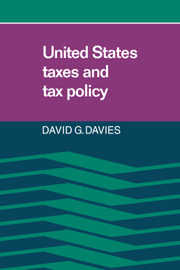Book contents
- Frontmatter
- Contents
- Preface
- 1 Economic foundations of U.S. tax policy
- 2 The individual income tax
- 3 Economic effects of individual income taxes and inflation
- 4 Expenditure versus income taxation
- 5 The taxation of capital gains
- 6 The corporation income tax
- 7 The corporation income tax and inflation
- 8 Social security payroll taxes
- 9 The value added tax
- 10 The sales tax
- 11 State taxes
- 12 Local government taxes
- 13 The distribution of tax burdens
- 14 Status of U.S. taxes and policy
- Appendix
- References
- Index
3 - Economic effects of individual income taxes and inflation
Published online by Cambridge University Press: 05 May 2010
- Frontmatter
- Contents
- Preface
- 1 Economic foundations of U.S. tax policy
- 2 The individual income tax
- 3 Economic effects of individual income taxes and inflation
- 4 Expenditure versus income taxation
- 5 The taxation of capital gains
- 6 The corporation income tax
- 7 The corporation income tax and inflation
- 8 Social security payroll taxes
- 9 The value added tax
- 10 The sales tax
- 11 State taxes
- 12 Local government taxes
- 13 The distribution of tax burdens
- 14 Status of U.S. taxes and policy
- Appendix
- References
- Index
Summary
The economic history of the world's nations reveals short-run fluctuations in the purchasing power of money with a persistent long-run upward trend of inflation. Governments from ancient China, Egypt, Greece, and Rome to those that exist today simply cannot resist paying their bills by debasing their currency through inflationary policies. The United States is no exception, and these policies have had a profound effect on our income tax.
Bracket creep
For purposes of calculating income tax liabilities, Congress has constructed numerous tax brackets, each normally including small ranges of income and an associated amount of tax on a given income that is due the government. Because the federal income tax is progressive, that is, the higher the level of income the greater the average rate of taxation, higher incomes that are in higher brackets are subject to higher rates of taxation.
Congress has defined these income tax brackets in current or nominal dollars. They are unadjusted for inflation. This means that as wages and prices increase, taxpayers are automatically boosted into higher tax rate brackets, even though their real incomes may remain constant or even decline. This phenomenon, in which individuals' taxes increase more rapidly than their current income, is known as bracket creep. An important consequence of bracket creep is that taxpayers find themselves paying larger and larger shares of their earned income over to the federal government.
- Type
- Chapter
- Information
- United States Taxes and Tax Policy , pp. 47 - 76Publisher: Cambridge University PressPrint publication year: 1986



